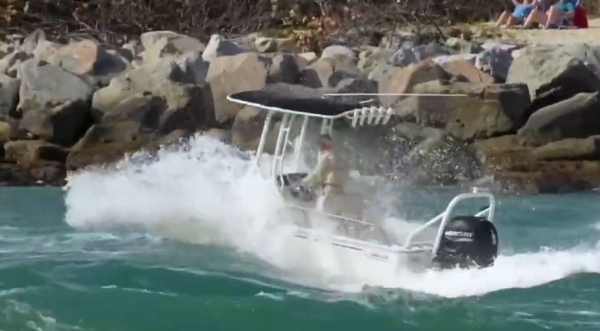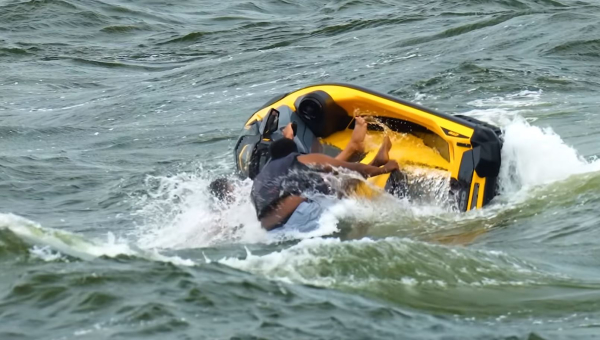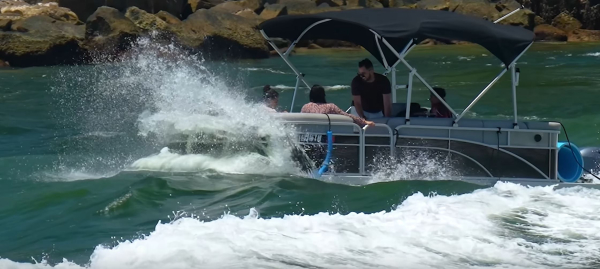If you look at YouTube at all, chances are you’re run across some of the videos made by multiple internet entrepreneurs of people doing really stupid things in boats. Who knew this could be so entertaining? These guys did, and it’s making them rich.
But the videos also teach us some important lessons about handling boats, stuff the crusty old salts consider second nature, but that is clearly news to most of the beginning boaters putting themselves in harm’s way in the videos.

Many videos are shot at Haulover Inlet, on Florida’s east coast just north of Miami Beach. It’s the main pass from the Intracoastal Waterway and the north end of Biscayne Bay to the ocean in that area, and so it gets a lot of boats of all sizes passing in and out. As a coastal pass, it also gets a lot of tidal flow, and at the same time it’s often exposed to large waves rolling in off the open Atlantic.
The result is a sort of marine washing machine, particularly when an outgoing tide meets big waves rolling in from the east.
The result is a thrill ride, even for experienced captains running large, capable boats. But with the advent of the avid search for a moment of Internet fame, more and more amateur boaters are loading up—or renting—boats to head out the inlet and have their moment of conquering danger recorded for posterity.
It’s common for a dozen or more bon vivants to cram themselves and all the beer they can carry into a 25’ center console on a weekend afternoon and head for the inlet at a time when they know the videographers will be standing watch.
In most cases, nobody wears a life jacket, and the majority of the party will be happily jammed into the front half of the boat, apparently hoping to be more visible to the cameras there.

The results are unavoidable on a rough day.
Even the best designed boats are not capable of carrying most of their load forward, particularly when facing head seas. The weight of multiple people up front makes it impossible for the hull’s buoyancy to raise the bow far enough to get over the uncoming waves. The bow “stuffs” or runs itself right into the wall of water, and the water pours back into the cockpit.
Once that first wave adds hundreds of pounds of water to the load, the next one rolls right over the bow as well—unless the operator realizes what’s happening and makes a quick U-turn, the boat is likely to sink within minutes.
Smaller boats with fewer people up front present a different risk—when the bow rises quickly over a steep wave, the guy at the bow goes airborne, and a second later he’s coming down just as the boat is rapidly coming back up again. He lands on his tailbone on the fiberglass bow, and will be best friends with a chiropractor for the rest of his life.
Even when boats are properly loaded, many run into trouble because the skipper doesn’t get the dynamics of dealing with the seas. Most boats take on a rough passage into head seas best if they’re put in a slight “squat”, that is given enough power to cause the bow to rise slightly and the stern to drop—this pace gives the most freeboard forward and the best shot at keeping everyone dry.
Oddly enough, this is one place where if you go slowly and cautiously, you lose. If you pull back to idle speed—which is often the reaction of an operator new to seeing waves taller than his head coming at him—the bow will sometimes ride right down the face of one wave and stick into the next one. Again, it may result in green water over the bow.
Of course, some boats are just a lot more seaworthy than others. Lots of freeboard and flair forward are indicators of a good rough water boat. At this particular inlet, most boats 35 feet and up blow right through so long as they don’t slow too much and get on the rocking horse. Some guys in go fast boats with 4 or 5 big outboards ride through at 50 mph and barely take a bump, riding flat and level and letting the sharp vee bottom cushion the ride. In general, boats with fully enclosed bows do a lot better than those with open bows like center consoles and bowriders.

On the other hand, sometimes captains more intrepid than wise try to take pontoon boats out the inlet. A pontoon boat is basically a piece of plywood on two aluminum floats. A wave over a couple feet tall will often roll up on top of the plywood instead of under it, and you’re immediately in trouble. Pontoons are wonderful family boats but have no place outside coastal inlets in most areas.
All told, watching these YouTubers can be instructional for all who run boats in challenging conditions on occasion—and I have to admit, they’re pretty darn entertaining, as well. See them at Wavy Boats, Boats vs Haulover and others.
-- Frank Sargeant
Frankmako1@gmail.com